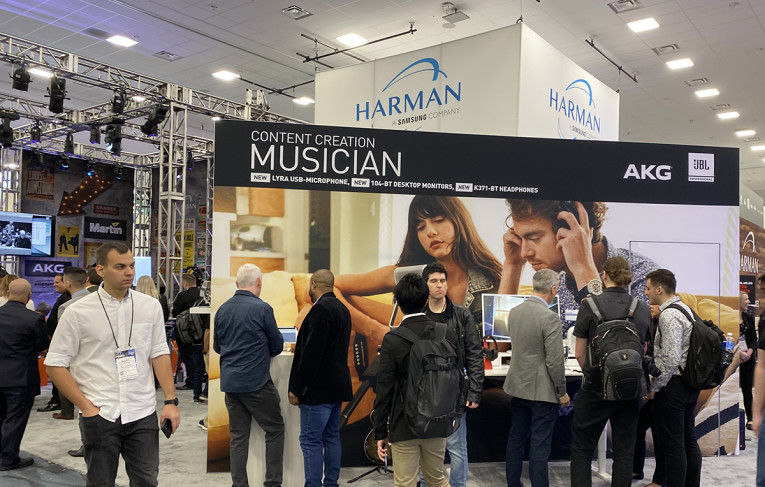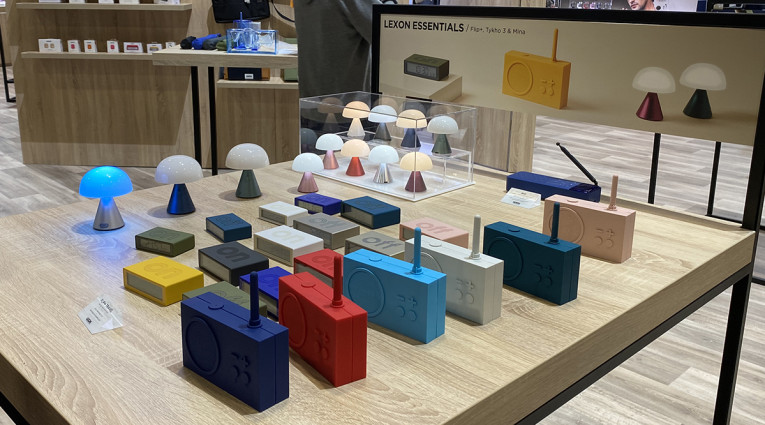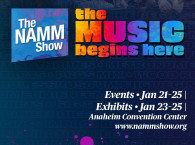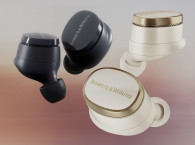In contrast, having just started another edition of the NAMM show in Anaheim, CA, which this year occurs shortly after CES (with little more than a weekend in between), there's a real excitement that's palpable on the show floor, with booths literally invaded by enthusiastic users/endorsers/clients and the roar of technology being used - as it's meant. And I'm writing this after just a few hours of quickly walking (running) the show, following press conferences one after another.
That's something that I guess is missing from the giant consumer technology market that is CES, where the actual show floor is mostly void of actual excitement and enthusiasm and business is conducted in meeting rooms and suites behind closed doors. "Well, CES is a trade show, there are no actual users walking the floor," I hear you say. Well, just imagine if there were. Would you see anything similar to the NAMM show?

At CES, very few brands could sell T-shirts with just their logo. In reality, companies give them away all the time, and do not necessarily generate much excitement from the receivers. "Yes but the visitors at CES are traders, not fans," you might remark again. That's true, but then why do people - even members of the media - rush to grab any type of swag being offered by some companies, completely ignoring giveaways from others?
I think this is something with huge implications when manufacturers struggle in a market where differentiation is an issue. If consumers are already emotionally involved with a brand, it's half the way to gaining the business. Among the main audio product trends that I noted at CES 2020, was a big struggle for product differentiation in the most desirable segments such as wireless headphones and, in particular, true wireless stereo. The technology platforms that are available now from the chipset vendors, are already leveling the field, and in one more year, they will make products even harder to differentiate.
And that's precisely what - in my opinion - is already happening in the wireless loudspeaker segment . At CES 2020, this was extremely clear. There were hardly any new portable speakers, smart speakers, and - surprisingly - very few soundbars (even though we saw many ambitious prototypes in closed rooms). And in many of the meetings with consumer brands, this year companies were giving away Bluetooth speakers, instead of pens or T-shirts. That's a clear sign that the market is totally saturated with me-too products that consumers have trouble differentiating. And after a few years filled with enthusiasm, when even smartphone companies have launched portable wireless speakers, the shelves are now crammed with cheap products that "play sound" and the consumer's perceived value has eroded.

The 8K Seeming Paradox
At shows such as CES, there are always new trends and new product categories. This year, as all the mainstream media reported, it was all about 8K displays. But mostly everyone who learns about 8K TVs asks: Why do we need 8K? Why would we need an absurd level of image resolution (and gamma detail) when people seem to be perfectly happy with their HDTVs, and they have barely started to appreciate how good 4K displays can be.
Well, there's the answer. We needed High Definition (HD) to have decent quality TV, which the original NTSC/PAL, etc., composite/interlaced formats never delivered. But in that transition, instead of 1080P 60 (P for progressive scanning, which actually means 60 full frames per second, not 30 half resolution frames), broadcasters gave us 720p 30/25 frames per second, or worse, 1080i 30/25 interlaced, essentially used as a way for cable/satellite/IPTV operators to reduce bandwidth and save costs. It wasn't until those same companies started to announce 4K to remain competitive, that we finally started to really receive a decent HD signal (1080P 60, if we are lucky).

So, the reason why we need 8K displays is to push the content and distribution market forward, so that we are all finally able to enjoy real 4K resolution (which is in fact the same as saying 2,160P - it doesn't sound so sexy, does it?). Eventually, working toward 8K will mean we will be able to get something like 4K at 120P (progressive frames per second), which is the minimum decent frame rate for live action to become something closer to human perception and not movies.
And yes, much in the same way as our smartphones already shoot video at 4K/30, and we can get 4K HDR straight from the Internet, also future TV displays will offer higher effective resolutions than movies, because they use different languages and aesthetics. So, the next time someone says: "we don't need extra resolution," or "no one ever notices," or the like, what they are really saying is, "we are not able to give you the excellent quality that content producers generate and that you deserve."
And in fact, it's a very similar situation with audio quality, when streaming music services tell you that "no one can hear the difference" between an uncompressed 24-bit/96kHz master recording and a compressed AAC at 16-bit/44.1 kHz, even though they actually store the master files in their servers. It purely means - we do not have any reason to improve our service, because we make more money this way - and we'll keep on doing it while we can.

Should we be shocked with companies pushing the envelope at shows like CES to find the "next big thing"? No, we should be shocked by companies that stop trying, embrace "good enough," and are quickly squashed by disruptors - with or without merit. aX
This article was published originally in The Audio Voice 261 newsletter, January 17 2020.
Register here to receive The Audio Voice weekly: http://bit.ly/1ri0b4J







